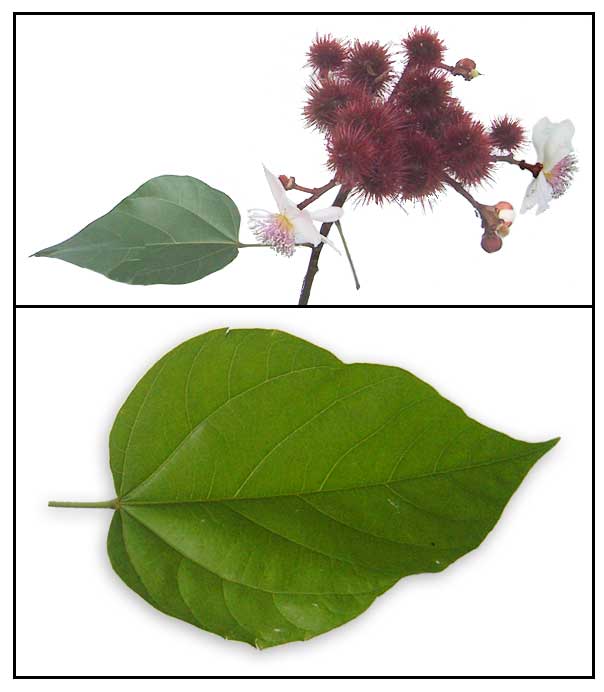Achuete-Bixa orellana Linn.
 Gen Info
Gen Info Next to caramel, annatto is the world's most important natural colorant yielding yello to red colors. There is global commercial production of the seed, estimated in 1990 at 10,000 tons per year; Brazil being the largest exported.
Botany
A tree reaching 4 to 6 meters. Leaves are entire, ovate, 8 to 20 cm long, 5 to 12 cm wide, with a broad and heart-shaped base, and a pointed tip. The flowers are white or pinkish, 4 to 6 cm diameter, 4 to 6 cm in diameter on terminal panicles. Capsules are ovoid or rounded, reddish brown, about 4 cm long and covered with long, slender and soft spines containing many small seeds covered with a dye-yielding red pulp.
Distribution
Pantropic; planted throughout the Philippines.
Chemical constituents and characteristics
The coloring matter in the seeds is bixin.
Seed contains a fatty oil with palmitin, a little stearin, and phytosterol.
Fine powder covering the seed is hemostatic and stomachic.
Root-bark is antiperiodic and antipyretic.
Diuretic and purgative.
Aphrodisiac and detoxifier.
Seeds are slightly astringent.
The pulp (annatto) surrounding the seeds is astringent and slightly purgative.
Study of carotenoid pigments in the seeds identified bixin, norbixin, ß-carotene, cryptoxanthin, lutein, zeaxanthin and methyl bixin.
Parts utilized
Leaves, bark and seeds.
Uses
Folkloric
· For small burns: Wash the leaves with soap and water. Boil 10 leaves in 5 glasses of water; cool. Soak the burn area for 10 minues, once a day.
· The pulp of the seeds, immediately applied to burns, prevents blistering and scarring.
· The seeds, ground and boiled, also used for burns.
· Fresh seeds when moistened produce a reddish colored juice that is applied to red rashes.
· The seeds are used as antidote for cassava and J. urcas poisoning.
· The achuete dye used with lime for the treatment of erysipelas.
· Also used for wound healing, regulation of heavy menses, and thinning hair.
· The leaf, bruised with the head of a "walis-tingting" (broom made from frond ribs of the coconut leaves), mixed with warm coconut oil is applied on the forehead for headaches.
· An infusion of the leaves used as purgative.
· Poultice of leaves are diuretic and used for treatment of gonorrhea.
· Leaves for snake bites
· Decoction of leaves for nausea and vomiting.
• In traditional Peruvian medicine, used to treat heartburn and stomach distress caused by spicy foods; also, as a vaginal antiseptic and cicatrizant.
• In West Indian folk medicine, used for diabetes mellitus.
• In Guatemala used for treatment of gonorrhea.
Others
· The main product from B. orellana is an organic dye present in the seed coat called "annatto," lipid-soluble and widely used in the food industry for its red to orange-yellow colours (cheese, butter, oils, margarine, ice-cream, pastries). Next to caramel, it is the world's second most important food colorant.Besides providing an attractive color to meat and other dishes, it also imparts a subtle and distinctive flavour. In the cosmetic industry it finds use in hair, nail and soap products, and also in the many of the household products – floor wax, shoe polish, russet leather, wood stains.
• Female aphrodisiac in the Amazonia.
Studies
• Antimicrobial / Antifungal: (1) The study screened plants extracts - including Bixa orellana – for antimicrobial activity and MIC. B orellana showed low MIC against against E coli and a better MIC against B cereus. Results showed that Bixa orellana, Justicia secunda and Piper pulchrum could be potential sources of new antimicrobial agents. (2) Study of organic extract of BO showed to possess a narrow spectrum of antimicrobial activity, effective only against Gram+ bacteria used in the study.
• Antibacterial / Antioxidant / Antidiarrheal / Neuropharmacolic / Anticonvulsant/ Gastrointestinal Motility Effect: Preliminary pharmacologic studies on the methanol extracts of BO leaves showed statistical decrease in locomotor activity, anticonvulsant effect, analgesic and antidiarrheal effect and a delay i gastrointestinal motility. It also showed radical scavenging properties and antibacterial activity against agents of diarrhea and dysentery.
• Hypoglycemic / Antidiabetic: (1) Study of BO oil seed suspension of the red seed coat showed it to be a potent hypoglycemic agent. Extract study showed hypoglycemia in both normal and streptozotocin diabetic dogs. (2) Annatto extract was found to decrease blood glucose in fasting normoglycemic and streptozocin-induced diabetic dogs. The activity was attributed to the stimulation of peripheral utilization of glucose.
• Milk-based pigment: Study showed B orellana seeds can be used as a pigment in making milk-based paint.
• Anti-Gonorrheal: In a study of 46 plants popularly used in Guatemala for the treatment of gonorrhea, B orellana bark was one of the most active plants that inhibited strains of freshly isolated N gonorrhea.
• Antibacterial / Anti-Staphylococcal Activity: Study showed crude ethanolic extracts from leaves of B orellana and bark of Alstonia macrophylla showed potential antibacterial effect against S aureus.
• Aldose Reductase Inhibition: Study of hot water extracts of B orellana, C morifolim and I batatas showed potent inhibitory activity towards lens aldose reductase. Phytochemicals yielded isoscutellarein from B orellana as its potent inhibitor.
Availability
Wild-crafted.
Small scale local cultivation for condiment and food colorant.
Worldwide production of annatto seeds for commercial and home use.



0 Response to "Achuete-Bixa orellana Linn."
Post a Comment